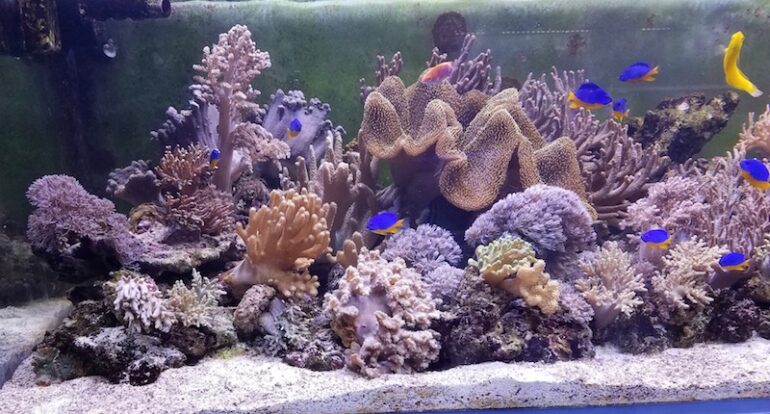I have a wonderful 21-year old daughter, who I have spoiled over the years. During that time, I have also spent a lot of time trying to teach her the difference between wanting something and needing something.
Unfortunately, learning the difference between these two is not only difficult for her, but it is difficult for many of us in the hobby as well, especially when we are starting out. This is undoubtedly due to a number of factors. First, there now so many pieces of equipment out there with new pieces of equipment coming online all the time, that it makes everyone feel like we have to have them in order to succeed.

Second, and in my case even worse, new brilliantly colored or unique fish and corals seem to constantly appear online or at shows, and if you are like me, you feel that your tank will not be successful or impressive if you do not add them to your tank. So for someone just getting into the hobby this can be overwhelming.
Unfortunately, all of this equipment is not necessary, and for someone starting out it often causes them to want equipment that they may not really need. For many individuals entering the hobby seeing these corals or new pieces of equipment and their prices makes them feel that this hobby is incredibly expensive in that they think they need them all in order to be successful.
Since I talk to many new hobbyists, I often get the question: “what do I really need in order to have a nice tank”, as that s all they really want, and do I really need all of this expensive stuff?” Obviously, there is no definitive way to answer this, since everyone has their own idea of what a successful tank is and has different finances, so there is no definitive answer.
But after helping many newbies set up tanks, I think I have a pretty good idea of what they may need versus what they may want to have in their tank or use on their tank in order for it to work and bring them enjoyment. And to me having a tank that brings enjoyment is the best criteria for determining if a tank is successful or not. I’m sure that there will be lots of opinions on what I think is “needed” versus what is wanted, and I welcome the discussion.
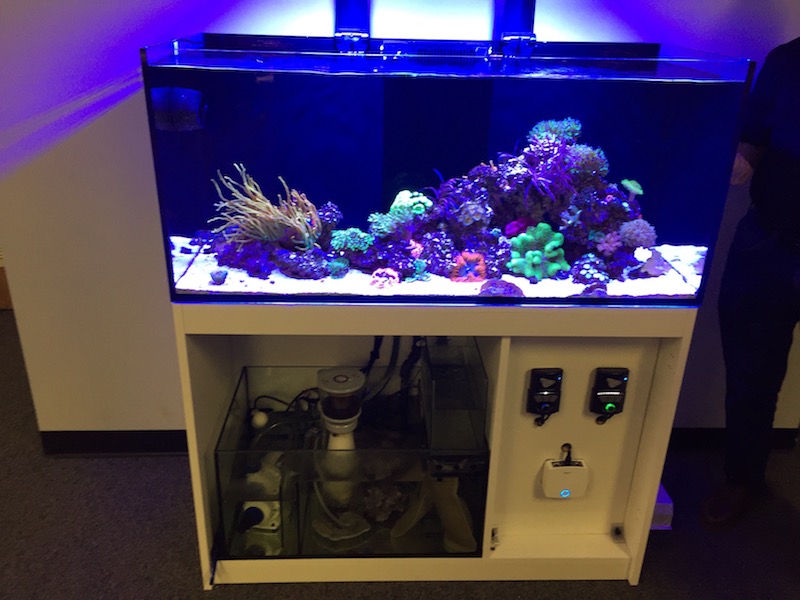
As I was thinking of writing this and putting together my ideas, the thing that kept popping into my head the most, was how most people looking to get turned away because of how expensive this hobby has become. And when you look at it from when we started keeping corals or even saltwater in general 30 plus years ago, it actually has always been an expensive hobby, but now even more, the cost have gone over the top.
However, I do not want this article to be about that, but rather I want it to be about what is needed to get into it, while looking at the cost as secondary. So for anyone looking to get into the hobby, the first thing they obviously need is a tank and stand. When I am asked which ones to get my first suggestion is always to get the best and most affordable you can buy.
To me size is kind of irrelevant, in that you can have a beautiful tank that brings you enjoyment that is small in size just as well as you can have one that is 500-gallons in size. Which one you choose depends on how much space you have, how you want to stock it and how much money you are willing to spend. The three are interrelated and you really cannot look at one factor as much as you need to look at all three. Having said that, when I am pressed, I generally suggest people starting out get a tank between 90 and 240-gallons.

To me these are in the sweet spot in terms of size, the WOW factor and when assessing the cost per gallon generally provide the most value. At these sizes there are also a good number or reputable manufacturers so there are several options available. But regardless of which size tank and manufacturer is chosen, I always tell new hobbyists to get the highest quality tank and stand they can, ones with the best reputation.
Regardless of what else they do with their tank, if the tank fails or if the stand fails or if the tank fails due to the stand, everything else they do will be money wasted. I say this because when a tank breaks and floods a living room, or basement or wherever, the whole tank will usually be lost as the significant other will be very unlikely to let another tank into their house. So these are two pieces of equipment where spending the money for the best made is the best way to go.
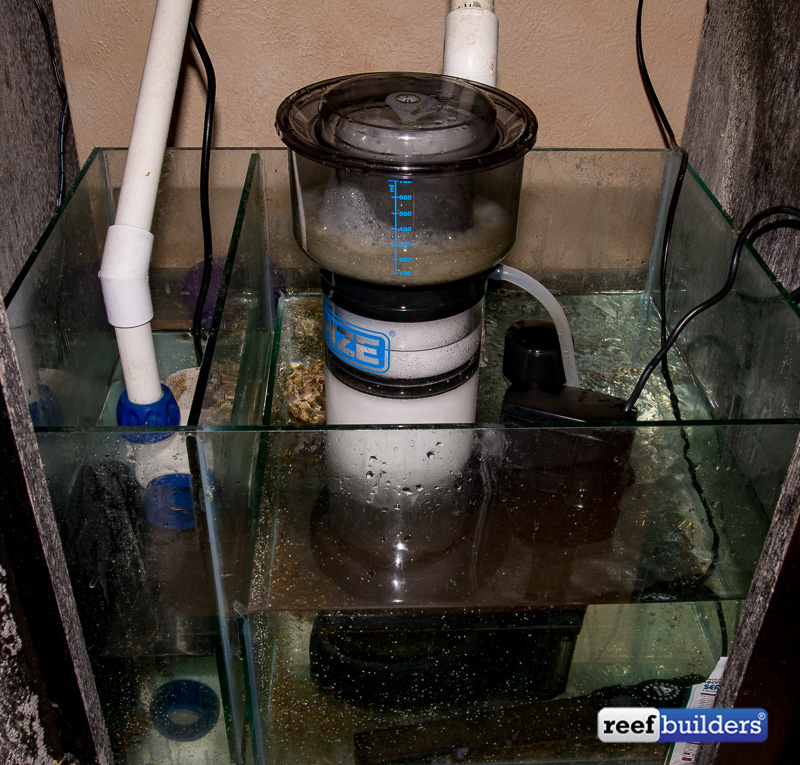 The next things that will be needed is a good protein skimmer and for most tanks a sump. Virtually all of the tanks I have had over the years or have helped set up have also included a sump, so this is another necessary piece of equipment. Since the early 1990’s a good protein skimmer has also been on every tank as well.
The next things that will be needed is a good protein skimmer and for most tanks a sump. Virtually all of the tanks I have had over the years or have helped set up have also included a sump, so this is another necessary piece of equipment. Since the early 1990’s a good protein skimmer has also been on every tank as well.
While there are now countless protein skimmers on the market, with some amazing designs I have not seen one that is at least to me significantly better than the others. So when choosing one, all I suggest is to get one sized for your tank and that is easy to maintain. To me having one that is easy to maintain means you are more likely to clean it regularly, and by doing this you will make the skimmer more efficient than one that may be more efficient but that is more difficult to to maintain. In this regard, also get a sump that is easy to work in as too.

There are now some incredibly designed sumps out there that have chambers for everything and that look really slick. I would love to say that you need them, but in reality I have found that simpler is better when it comes to sumps and that is why I use old tanks as all my sumps. On my 300-gallon tank I use an old 90-gallon tank. While my two 120-gallon tanks each use old 40-gallon tanks as their sumps. I use them because not only are they inexpensive, but like the tank itself I am pretty sure they will not leak and lead to other problems.
The next pieces of equipment that will you need on a tank is an overflow of some type and a return pump. Many tanks available today have built in overflow boxes, and if the one you pick does this then is not a concern. However, if your chosen tank does not then you will need to get one.
In this regard I suggest getting one or actually two that will handle the flow from the tank to the sump. I suggest two as it has been my experience that when you are looking at one area with a pronounced likelihood of failure and said failure causing a small flood it is the overflow box. So this is why I suggest getting two and even better getting two with individual pumps to keep their siphons from breaking.
Doing this will also give you peace of mind should you travel a lot or go on extended vacations. These overflows do not need to be huge like they used to be, as you are not looking to turn the water over through the sump more than 10 times per hour, unlike what we used to do in the past. This smaller amount of turnover in the tank allows for longer contact time with the protein skimmer as well as any other filtration technology that will be employed.
And since the tank’s volume will not be turned over as much as it had been in the past, a smaller return pump can be employed. I prefer using a smaller pumps as they are less expensive, quieter and easier to plumb and replace than larger pumps. These small return pumps on my tanks are not moving more than seven times the tanks volume per hour, which also reduces electricity usage.
Using smaller return pumps however does not mean that flow in the tanks is reduced. Quite the contrary, as it is my belief that one of the things that is truly needed for a tank to thrive is good water flow. On all of my tanks I employ as much water flow as possible short of having it shear off the tissue from the corals.

My tanks use not only standard powerheads, but also wavemakers, gyres, and Sea Swirls. I employ all of these devices in an attempt to generate as much random flow in my tanks as possible. As I found out while doing some research most of the most successful tanks I have seen have water motion in them that is at least 20 times the volume of the tank and some times up to 60 times the volume.
In my own tanks, with everything else being equal, my corals have been healthier and grew more quickly when stronger water motion was employed versus less water motion. Powerheads and other water moving devices all move water in various ways, which ones you choose again depends on budget and how much movement you desire.
Water motion production does not need to be complicated as long as there is some flow everywhere in the tank. Dead spots in tanks with high water motion often seem to lead to dead spots where detritus can accumulate, and this is bad for any tank and needs to be avoided.
The next piece of equipment needed to start a tank is lighting. Since the beginning of the hobby this topic has been the most controversial in that there have always been lots of choices, but none were considered to be perfect. This is still the case today, but too a lesser degree as hobbyists still hotly debate which type of lighting is best, but now there are even more choices.
In the early days of the hobby, the goal was to get as much light over the tank as possible. SO for this reason metal halides became the lighting choice for most of us. However, as we have learned and as new types of lighting have become available, many of us have switched to using LED lighting. I currently employ LED lighting on all of my tanks, both those growing sps as ell as my lps and soft coral tanks.
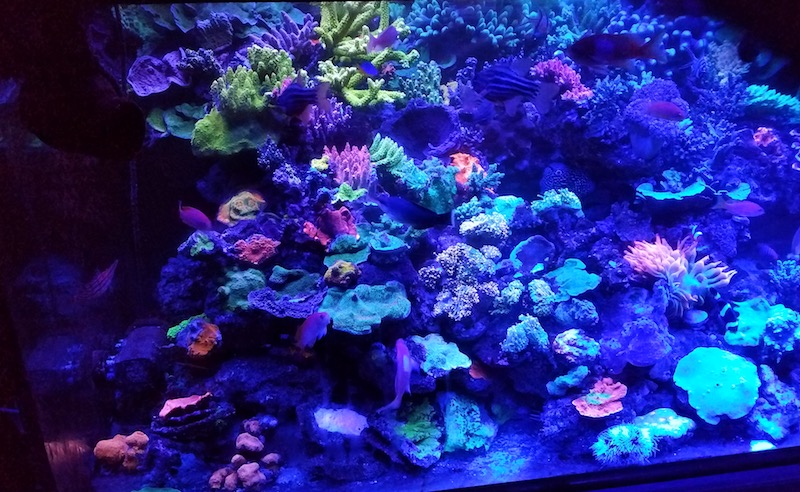
But I have also seen innumerable successful tanks also employing t-5 fluorescent lighting and halides as well as various combinations of these lights. Unlike most things used in the hobby, lighting really is an individual choice in that some of us like bluer light while others like whiter tanks.
With so many lighting options available and so many manufacturers producing good products choosing what lighting is needed is now even more difficult, especially when you are trying to set up a new tank. For someone starting out I suggest that you look at as many tanks as you can that use different lighting and then select the lighting that appeals to you. Actually it is a good idea for anyone starting out to look at multiple tanks to help refine what you really need versus what you may want, but this is especially true when choosing lighting.
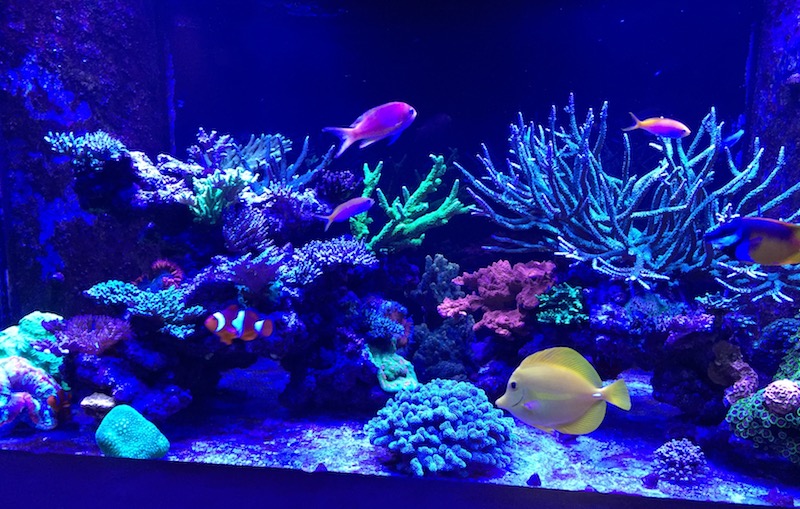
Unlike lighting, on which there are countless opinions, I think everyone will agree that starting with good quality live rock is the best way to start a tank. While I know there are the “dead” rock advocates, it has been my experience that my tanks have done better both short and ling-term and have matured faster when I have used the best quality live rock I could find.
Fortunately, as we have learned and have gotten better at both aquascaping and growing corals we no longer need to use nearly as much live rock as we once did. Whereas even 10 years ago the standard amount recommended was 2 pounds of live rock per gallon, now many of us use less than half a pound per gallon, which allows not only more space in the tank in general, but also provides more space for the corals to grow into and fill up. As with lighting, how a tank is aquascaped is a individual decision, with my only suggestion being not to aquascape your tank so that it looks like a fruit stand.
Since all corals require calcium, carbonate and other minerals to some degree the other pieces of equipment that are needed is some kind of means for their supplementation. For this two different means are generally recommended: either a calcium reactor or a dosing system.

I currently employ a calcium reactor on my larger system and use a 3-part dosing system on my smaller systems. After using both systems different systems I cannot really recommend one over the other as both keep the calcium and alkalinity in their respective systems stable and at the desired levels.
Only when I have gotten lazy and not maintained this equipment or tested the tanks regularly have there been problems. Since there are now so many reactors and dosers now out there again it is best to see what is available and that you can afford. I suggest that you do not try to save money by doing daily dosing yourself as over time this becomes tedious and if you are ever away for any length of time it can be a real problem so automate this as much as possible.
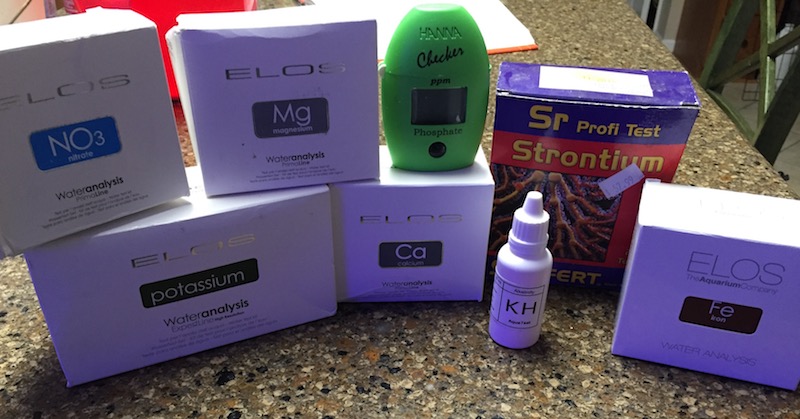
The last main pieces of equipment that you need are test kits. There are now test kits on the market to measure just about every parameter in a tank so it is no longer necessary to guess what a level of something is. I use test kits to measure alkalinity, to me the most important parameter, as well as calcium, magnesium, nitrate, phosphate, potassium, and when you are starting out and especially when you are cycling a tank ammonia and nitrite.
You also need to get a high quality refractometer to measure the salinity of the water in the tank as well as when you do water changes. These parameters should be tested weekly using these kits, so choose kits that are easy to use so it will be more likely that you will use them. Some kits are slightly more expensive than others, but this difference is usually minimal when you look at it on a cost per test basis.
Being reliable and easy to use will save you far more money in the long run than will saving a bit on the cost of the whole kit. Also do not try to save money by getting a plastic hydrometer, they have been found to be unreliable over time and can cause major problems. A good thermometer to measure the tank’s temperature is also a needed item. Along with this goes a heater, but unfortunately I still have not found a heater that to me has proven to be reliable over time. So choosing one, at least for me, is still pretty much of a crap shoot.
The items I’ve listed are for the most part all that you really need to get started, and you can spend from hundreds to thousands of dollars just on these items. While there are now monitors that measure just about everything as well as controllers that can help automate some of the tasks you need to do, in my opinion these are want items rather than needs.
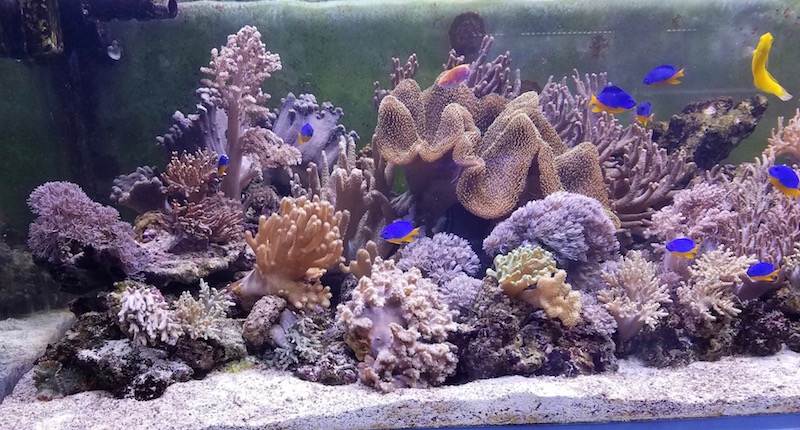
Over time as you become successful and want to do less and enjoy your tank more these can be added, but you really do not need them to be successful and enjoy your tank. As I said at the beginning of this article, to me a successful tank is one that you can sit back and enjoy.
So whether it is a soft coral tank where the corals sway in the current or an sps tank fully of vibrantly colored corals or something completely different if you can sit back and enjoy it is successful. In any case, especially when you are just getting started you really do not need everything that is out there. And in my opinion and experience, being successful while keeping things simple over the long run will allow you to enjoy the hobby more whether you add on all the things you want or not.


